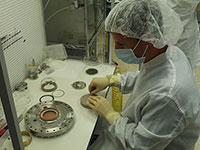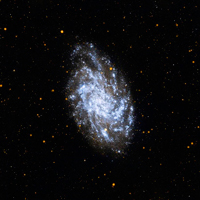Patrick Morrissey
A Lens Grinder Reflects on GALEX Instrumentation
Profile by Sandi Beck

Patrick Morrissey learned about science at an early age from his father, who is a chemist. To the youngster, his Dad's white lab coat and the laboratory filled with mysterious chemicals was fascinating. However, because his Dad has a broad interest in science, Patrick was introduced to many of the disciplines beyond chemistry. Of these, astronomy intriqued him the most. So, when his parents gave him his very first telescope at age 12, he joined the local Rhode Island astronomy club. Called the Skyscrapers, the club was founded in the 1930s in association with Brown University. It had a great little observatory in a rural area with a meeting house and old refractors.
"I have many fond memories of observing out there with small telescopes," Patrick muses, "listening to Peep-toads singing late at night."
When he was 13, Patrick decided to build his own telescope--an eight-inch Newtonian design. From his many jaunts to the Providence Public Library, Patrick had learned that telescope making was very popular in the early 1900s, when it was considered an art. Back then many amateur astronomers ground their own lenses and mirrors in order to achieve more affordable light-gathering ability. Some even used port-hole glass from boats for mirror blanks. At the time that Patrick was 13, however, lens grinding was done by only a handful of people, a few of them Skyscraper members. Of those who did, many showed their telescopes at Stellafane, an annual event for telescope entrepenuers, drawing large crowds. As part of his project, Patrick decided to grind his own lens, just like artisans of "old."
So, armed with the classic book How To Make a Telescope by Jean Texereau, Patrick began. From ads on the backs of "Sky and Telescope" magazine he learned where to buy the abrasives and glass blanks. And, members of Skyscrapers helped him with optical testing. Once done, Patrick entered his telescope in the Rhode Island state fair, where it won several ribbons. He then took it to Stellafane, where he won a junior-telescope-making award.
According to Patrick grinding glass mirrors really isn't hard to do, but does take many hours of labor. "I have always been fascinated by the process of taking a rough, flat piece of glass and turning it into an exquisitely-shaped surface capable of focusing a beam of light to the diffraction limit," he says.
Moreover, doing your own grinding allows you to experiment with different optical and mechanical designs. Patrick explains that there are numerous examples of amateur telescope innovation that have become commercial successes. For example, the Edmund Scientific Astroscan (basically a four inch mirror in a bowling ball) first showed up at a telescope making convention. Also, the boom of the 80s and 90s in large aperture, thin mirror telescope was the result of designs developed by John Dobson of the San Francisco Sidewalk Astronomers (known as "Dobsonians").
Honing his telescope-making skills as a kid served to heighten Patrick's interest in astronomy. And conversely, the study of astronomy uniquely combines physics with the multi-disciplinary field of instrument-making. His journey into building his own telescope set him on the path to where he is now--the detector scientist on the GALEX mission, currently observing galaxies in ultraviolet light across ten billion years of cosmic history.
After high school, Patrick stayed close to home and attended Brown, which is mainly known for its liberal arts program. However, he majored in physics and became a teaching assistant for the astronomy program. On campus, his interest in astronomy made him enough of a novelty to be frequently invited along to dinner with visiting seminar speakers, some of whom were quite famous--Steven Hawking, for example.
As a senior Patrick applied for a grant to work at Harvard College Observatory, where he got his first real dose of laboratory astrophysics. There, he helped develop a bench-top interferometer for a project that was to measure more precisely than ever before the positions of stars in the sky. He was fascinated by the world of precision measurement and amazed at how the interferometer would measure barometric pressure variations as storms moved through. "Although a systematic "error," it was interesting to me!" he declares.
Patrick then attended graduate school at Johns Hopkins University, which has a long history in instrument development. Some of the common ultraviolet optical designs used today are based on early work done there by Rowland, Wood, Fastie, and others. There, he got his first introduction to ultraviolet astronomy, and he also worked on sounding rocket experiments that launched from White Sands Missile Range in New Mexico. Those experiments were invaluable, because design and flight qualification for sounding rockets is very similar to what NASA does for satellites.
His graduate work led him to a position at NASA's Goddard Space Flight Center where he worked on high resolution ultraviolet detectors. "We made good progress at Goddard on a new technology that has the potential to significantly improve the performance of ultraviolet imagers," says Patrick. "but ultimately I missed working on flight projects, and that is really what brought me to GALEX."
So, in 1998 Patrick came to Caltech to join the GALEX team as a post-doc. His work at Goddard made him a natural choice to help with the instrument development, and soon after his arrival he began commuting to Berkeley. There, he worked with co-investigators on building the large area detectors that enable GALEX to see such a large slice of the sky (two full moons) in every image. They all spent many late nights testing and refining the process to build the one-of-a-kind detectors that are at once high-tech and hand-crafted. Of the four flight quality units eventually completed, no two are exactly alike.
Patrick plans to continue his role as an instrument scientist, interfacing between theorists and hardware teams to develop novel machines that look farther, or somehow differently, than we have looked before. When asked what he considers his greatest career achievement to date, Patrick answered, "GALEX, of course! This project has blended much of what I've always been interested in together into one project, and to see it come together and work the way it has is gratifying."




